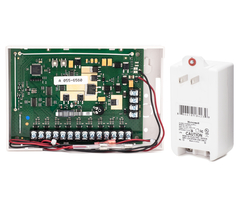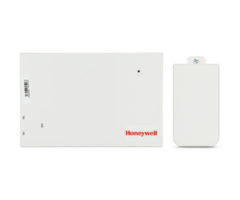Explaining A Trouble Condition On A 5800C2W Zone
Related Products


Related Categories
Description
In this video, Joe discusses the trouble conditions that can appear on a 5800C2W zone. When a trouble condition affects the 5800C2W itself, the system will display the condition on the lowest calibrated zone used with the module. This does not necessarily mean that anything is wrong with that zone.
When a trouble condition appears on the lowest calibrated zone, the user might be inclined to believe that something is wrong with the sensor associated with that wireless zone. But more often than not, this is not the case. The more likely scenario is that the 5800C2W Converter itself is in a troubled state. This setup makes it fairly easy to identify when something is wrong with the 5800C2W, but it can lead to some confusing situation if the user doesn't know what to expect. For example, a user might see a "tamper cover" condition on the first 5800C2W zone, even if the associated hardwired sensor has no tamper cover. This simply means that the tamper cover has been opened on the 5800C2W.
There are four trouble conditions that are commonly associated with the 5800C2W. These are AC loss, low battery, supervision and tamper cover. The condition will show up through the lowest calibrated zone. An exception is for supervision, which will show up on any affected zone. Additionally, a user can also program an optional supervision zone on Loop Number 4 that will also display the supervision loss condition. This optional supervision zone will use the lowest available Serial Number for the 5800C2W.
The 5800C2W module also features some LED lights that can be used to diagnose trouble conditions as well. For AC loss, LED light #2 will be solid red. For Low Battery, light LED #3 will be solid yellow. Both supervision loss and a tamper condition do not produce any lights. These conditions will only be displayed on the panel.
http://alrm.gd/get-monitored
Transcript
Hi, DIYers. Joey from Alarm Grid. And today, we're going to talk about why you may have a troubled condition on your 5800C2W. Now the 5800C2W can be kind of confusing with its troubled conditions for one reason, and that's that the troubled condition is going to show up on your panel as the lowest calibrated zone from your C2W. So as you can see on our C2W, we have the first zone shunted with a 2.2K resistor. Let's say I programed this into my system as the front door. If I do something to the C2W, such as take the cover off of it, like I've just done, that will show zone one, front door, tamper. Now if you have a wired contact connected to this, it may get confused because it's like, wait a minute. There's no tamper on my wired contact. What's going on here? It's actually telling you that the C2W itself has the tamper condition. Now this is going to go the same for any of the other trouble conditions on your 5800C2W, other than the supervision. Supervision is actually going to show on all of the program zones from the C2W in your alarm system. The other trouble conditions, though, tamper, DC power loss, or low battery, those will actually show on the first or the lowest calibrated zone on your C2W. So if we did have a low battery condition, which it looks like we do have, that will also show front door low battery. If you have a DC power loss, that's going to show front door DC power loss or something of the sort. Those trouble conditions will reflect, though, based on what you have programmed as that lowest calibrated zone. And it can get confusing if you don't know what to look for. Well, let's say you go to your system. You have a touch screen system. You have the 5800C2W programmed into it. And it says front door tamper, zone one front door tamper, or zone whatever front door tamper. What you can do is head over to your 5800C2W, and you can actually use the LEDs that are on the board to better diagnose and help figure out what's actually going on with the unit. As you can see, there's a bank of four LEDs right up here on the top. The first one has to do with the calibration of the unit. If it's green, it means that the unit is calibrated. If it's red, it means that the unit is in need of calibration. The second one has to do with the main power connection to the 5800C2W. If it's green, it means that the transformer is connected, and it's getting that 15.5 volts DC power. If it's red, it means that it doesn't see its transformer or the power connection's been damaged or there's something going on with that connection. If you do see that, you'll want to check the wiring for your power connection to the C2W. You're also going to want to head to the transformer and make sure it's plugged in and make sure that the wiring isn't falling off of the terminals on the back of it. The third light has to do with the battery connection. And as you can see, because it's yellow, it is showing us that our battery is low. But because we do have our DC power connection, it's actually charging the battery currently. That light is super convenient because you can see it through with the cover on. As you can see, there's a little window right here that'll show that light if it's illuminated. If it's off, it means that everything is all set. If it's yellow, it means that the battery is either low or that the device has disconnected it entirely. If the battery gets to 11.2 volts DC, it's going to show a low battery. The light's going to illuminate, and the system will get a low battery condition. That battery drops to 10 volts DC or below, the device is going to disconnect from the unit entirely. The fourth light on the bank, that has to do with the RF communication. As you can see, let's say I remove this leg of the resistor, that's going to flash. And it's going to show that the 5800C2W is actually signaling. Now when you're troubleshooting the 5800C2W, there's a couple of things to keep in mind. And there's a couple tricks that you can use. When you go to calibrate the unit, the 5800C2W is only going to recognize zones that have a resistor attached to it and that are closed. So let's say you did a panel swap, and you took a whole bunch of zones and you attached it to the 5800C2W, and you left some of the windows open that those zones are attached to, when you go to calibrate the unit, the 5800 isn't going to see those zones because they're open. And when you go to program them into your system, you may get frustrated because it's not going to learn them in when you go to open and close them. Even if you manually program in the serial number, they're still not going to work properly. So when you do attach any zones to the 5800C2W, before you do your calibration, just make sure that all those zones are closed. Another thing to keep in mind is that the trouble condition, as I said before, is going to show up on the lowest calibrated zone. So let's say you added zones to the 5800C2W, and the trouble condition comes in on zone number two, assuming that you programed them in manually just entering the serial number. Say, wait a minute. What's going on? Why isn't my front door showing that trouble condition even though it's attached to zone one. It must be because either the resistor wasn't touched correctly, it wasn't the proper resistance level on the resistor, or that the front door was actually open when you did your calibration. One way to avoid that is before you do your swap of a panel, taking all the zones from that panel and putting them on the C2W, keep your existing panel on. Go around the house and make sure that all the zones work, that they're all showing up in the keypad, label all of your wires, and make sure that they're all closed. This will save you a big headache in the future when you go to program this in to your actual alarm system. That's how to diagnose some of the trouble conditions on a 5800C2W. If you do have any questions about this, feel free to email us at support@alarmgrid.com, head over to our website, www.alarmgrid.com, or give us a call at 888-818-7728. If you did enjoy the video, feel free to subscribe. And if you want to be notified when we post future videos, hit the notification button below, and we'll send you an update when we do so. Thanks for watching and have a great day.
- Uploaded
